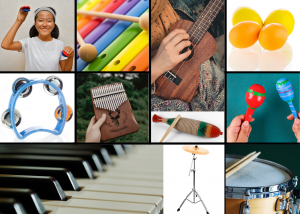Instrument Choice in Music Therapy
By Jamie Rowitsch – Registered Music Therapist & Neurologic Music Therapists
BSci(Music Therapy & Psychology) – Fredonia State University of New York
 Why does a Registered Music Therapist choose the instruments they choose for therapy sessions? Sometimes family members or clients ask, “Why the piano?”, “Why the gathering drum?”. There can be many reasons, and I’ll do my best to cover most of them here by outlining examples of specific instruments and the reasons music therapists may choose these particular instruments in sessions.
Why does a Registered Music Therapist choose the instruments they choose for therapy sessions? Sometimes family members or clients ask, “Why the piano?”, “Why the gathering drum?”. There can be many reasons, and I’ll do my best to cover most of them here by outlining examples of specific instruments and the reasons music therapists may choose these particular instruments in sessions.
Motor Skills
If a fine motor skill or grasp is an area of development your therapist is targeting, they may reach for the castanet, kalimba (see video below), or ukulele. The castanet promotes pincer grasp, something that may be useful as children learn to use a spoon or pencil for example. Kalimba targets finger isolation which can be useful in helping clients use adaptive communication devices. Ukulele could be used to strengthen these fine motor skills, as one would need finger isolation and maintained strength to hold down strings with the left hand, or controlled finger movement to strum the strings with the right hand.
Gross motor skills can be developed in many ways through music therapy, but one technique often used in neurologic music therapy is called Therapeutic Instrumental Music Performance (TIMP). When instrument play is used to motivate functional movement, this is called TIMP (Thaut, 2005). A client who is hoping to learn to cross midline may be presented with an intervention by their music therapist in which a snare drum is placed on the left side and a ride cymbal is placed on the right side. The client will be encouraged to keep their feet planted but use one hand to activate each instrument alternatively while the music therapist provides a steady beat using an instrument or the metronome. Because music and instrument play are naturally motivating, this is often a highly effective intervention in sessions.
Cognitive Function
Music therapists may choose an instrument such as a color-coded set of boom whackers (see video below), xylophones with bars that are letter-labeled, or a piano with numbered keyboard keys to prompt clients to practice divided attention (reading sheet music or written directives and playing the corresponding part of the instrument). This intervention could also help with school readiness and reading skills. It may also help the client improve sustained attention, and self-esteem, and feel a sense of accomplishment when they have completed an entire song independently.
Research has shown that cognition is well supported by rhythm and can enhance functioning. In one study, researchers found there was a connection between rhythmic regularity detection and reading skill (Bekius, Cope, & Grube, 2016). Rhythmic accompaniment is often provided by a djembe, hand drum, or claves – but is not always limited to percussion. A music therapist may provide a steady beat on a piano, guitar, or autoharp if it is found to be more interesting or motivating for the client to have a tonal aspect to the accompaniment.
Social Skills
Some data suggests that music therapy interventions in which the client and music therapist play the same instrument (such as a full-sized piano or large drum) may provoke more interaction than when they play different instruments (i.e., the client is playing the piano and the therapist is playing the xylophone) (Kalas, 2012). A music therapist may choose an instrument in which collaborative play is easy due to the size such as a piano or gathering drum. In contrast, if the client is working on independence or expressive communication, they may choose an instrument that stands out, such as a glockenspiel, while the therapist plays supportively but subtly in the background on a softer-timbered instrument such as the wooden marimba.
Turn-taking and play skills are easily practiced when using instruments such as lollipop drums or frog guiros because of the toy-like appearance of these instruments. Children can develop receptive communication by listening to sung instruction “Billy play the yellow egg,” when given a choice of green, blue, and yellow egg shakers.
The client’s strengths, needs, and preferences are the most important to consider when a Registered Music Therapist chooses instruments for sessions. Together with what the Music Therapists anticipate will be most motivating, rewarding, and effective, instruments are thoughtfully chosen for each specific session.
References:
Bekius, A., Cope, T. E., & Grube, M. (2016). The beat to read: A cross-lingual link between rhythmic regularity perception and reading Skill. Frontiers in Human Neuroscience, 10, 425. https://www.ncbi.nlm.nih.gov/pmc/articles/PMC5006315
Kalas, A. (2012). Joint attention responses of children with an autism spectrum disorder to simple versus complex music. Journal of Music Therapy, 49, 4, 430-452. https://doi.org/10.1093/jmt/49.4.430
Thaut, M. H. (2005). Rhythm, Music, and the Brain. New York and London: Taylor and Francis Group.
Above: Video of a Kalimba in action. Below: Check out the Boomwhackers in action.

